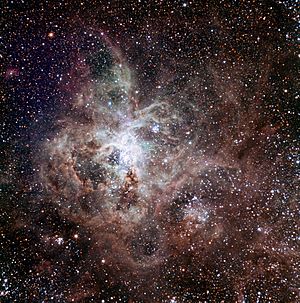Tarantula nebula facts for kids

The Tarantula Nebula is a giant cloud of gas and dust where new stars are being born. It is also known as 30 Doradus. This amazing place is located in a nearby galaxy called the Large Magellanic Cloud (LMC).
For a long time, people thought the Tarantula Nebula was just a single star. But in 1751, an astronomer named Lacaille figured out it was actually a huge cloud, or nebula.
Contents
What Makes the Tarantula Nebula Special?
The Tarantula Nebula is incredibly bright. If it were as close to Earth as the Orion Nebula, it would be so bright it could cast shadows!
Where is it located?
The Tarantula Nebula is about 160,000 light-years away from Earth. That's a very long distance! It is part of the Local Group of galaxies, which is our cosmic neighborhood.
Why is it so active?
This nebula is one of the most active places in the Local Group where new stars are forming very quickly. This process is called a "starburst region." The Tarantula Nebula is also one of the largest star-forming regions we know of in our Local Group. It stretches about 200 parsecs across.
Stars and Clusters Inside
At the very center of the Tarantula Nebula is a huge group of stars called NGC 2070. This cluster includes an even denser group of stars known as R136.
The R136 Cluster
The stars in the R136 group create most of the energy that makes the whole nebula glow so brightly. Scientists believe this star cluster has a mass about 450,000 times that of our Sun. It might even become a globular cluster in the future. A globular cluster is a very old, tightly packed group of stars.
Supernovae and Other Clusters
Besides NGC 2070, the Tarantula Nebula has other star clusters. One of these is Hodge 301, which is much older. The biggest stars in Hodge 301 have already exploded as supernovae.
The closest supernova ever seen with a telescope happened near the edge of the Tarantula Nebula. This event was called Supernova 1987A. It's hard to find the remains of other supernovae in this complex nebula because there's so much gas and dust.
See also
 In Spanish: Nebulosa Tarántula para niños
In Spanish: Nebulosa Tarántula para niños

